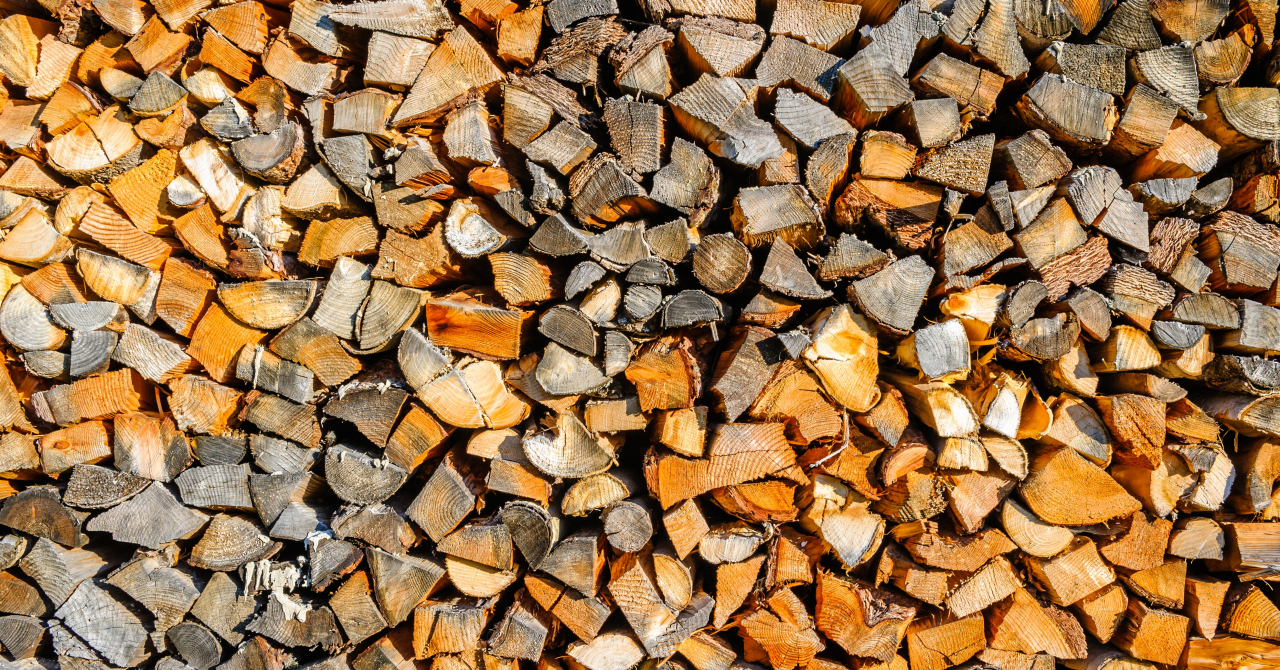Biomass energy is one of the oldest forms of harvesting energy in the history of humans, as it was used by our earliest ancestors for various things, such as cooking or warming.
What is biomass energy
Biomass is an organic type of energy, meaning that it comes from the materials of living organisms, such as plants and animals, with the most popular biomass materials being plants, wood and waste.
While biomass energy is a cleaner alternative to fossil-fuels, it doesn't necessarily mean that it is a renewable energy source, as the biomass feedstock is not a continuously-delivered resource, such as solar, wind or hydro energy. This means that biomass resources need more time to be replenished and we must make sure that we don't run out of it.
How does bioenergy work
Bioenergy or biomass energy works, for example, through processing the plants, which during their lifetime, turn carbon dioxide and water into nutrients called carbohydrates. They manage to do this with the help of sunrays, through photosynthesis.
The plants can then be processed directly or indirectly to obtain different types of power resources.
By directly processing plants, we can make either heat or electricity, and by indirectly processing them, we can obtain biofuel.
The direct processing of biomass is done through thermal conversion, which implies that the bio matter is burned and used for energy production. The most used biomass feedstocks for this process are municipal solid waste and scraps from paper or lumber mills.
When biomass is being burned, the steam that comes from it is used to move a turbine, which in turn activates a generator that produces energy.
Alternatively, biomass can be co-fired with fossil-fuels, which is a common process in coal plants.
Co-firing has a few benefits, such as eliminating the need for the development of factories that process biomass and easing the use of coal, which reduces emissions.
Several other products can be obtained through the processing of biomass, some of which are syngas, a product that can be turned into gas or methane, effectively replacing natural gas.
Slag is another product of biomass that is in liquid form and can be used to make asphalt and cement.
Industrial gasification plants are being used across the globe, most of which are being operated by Asia and Australia, but the largest of them all is being built in England, at Stockton-on-Tees.
When it will be completed, this biomass gasification plant will be able to process over 350.000 tons of municipal solid waste, turning it into enough energy to power around 50.000 homes.
Turning biomass into fuel
Biomass is the only renewable energy source that can be turned into liquid fuels, some of which are ethanol and biodiesel.
Ethanol, for example, is a renewable type of fuel that is made from various plants, and it is an alcohol that is mixed with gas in order to increase the octane rating and to cut down on carbon monoxide and other smoke-generating emissions.
Most ethanol is made from sugars and starches, and the method for obtaining the substance is known as fermentation.
Biodiesel is another liquid fuel produced from renewable sources, mostly from new or used vegetable oils, as well as from animal fats, and it is a cleaner alternative to traditional diesel.

Compared to its traditional counterpart, biodiesel is non-toxic and biodegradable, and it is being produced through combining alcohol with vegetable oil, animal fats or recycled vegetable oil.
Just like ethanol, it is used in a mix with regular diesel in order to make the latter greener and more eco-friendly.
Another way we can use biomass for fueling purposes is through hydrogen fuel cells, since the bio matter is rich in hydrogen, which can be extracted and used either for generating power or for fueling vehicles.
Stationary fuel cells are currently being used to power remote locations, such as spacecraft and wilderness areas.
One place in the world that makes use of hydrogen power cells is Yosemite National Park in the US, which uses this type of energy source in order to provide its administration building with electricity and heat.
Hydrogen fuel cells have a great potential for vehicles as well, since the US Department of Energy estimates that biomass has the potential to produce around 40 million tons of hydrogen per year, which would be enough to power around 150 million vehicles.
Due to their great potential and flexibility, hydrogen fuel cells are being used for powering various types of vehicles, such as buses, boats and submarines, and the technology should be implemented on other types of transportation systems as well, airplanes being one of them.
However, it is still being debated whether hydrogen fuel cells are a sustainable or economically viable option regarding renewable fuels, as it takes a lot of energy to isolate, compress, package and transport the hydrogen before it can be used.
Algae, the ultimate biomass resource
Algae is one organism that has great potential when it comes to being a biomass energy resource. Also known as seaweed, it produces energy through photosynthesis much faster than any bioenergy feedstock, a staggering 30 times faster than food crops.
Alongside this, algae also have another advantage in the form of preserving freshwater, since it grows in seas and oceans.

Since it grows on water, it doesn't take up valuable land space that can be used for growing crops, for example.
While algae still release carbon dioxide whenever it is burned, it can be farmed and grown, which in turn releases oxygen and absorbs the carbon dioxide and other emissions from the atmosphere.
Biomass advantages
One advantage of bioenergy is the fact that it is a renewable and widely available type of energy resource, but at the same time we must make sure that it stays that way, since new crops need to be grown in order to maintain this advantage.
Biomass is also carbon neutral, since when the plants are being burned, they release only the amount of oxygen that they absorbed through their lifetime, and by carbon capture, we can mitigate these effects even further.
By mixing biomass fuel products with fossil fuels, not only do we ensure that we lower the carbon footprint of the latter, but we also preserve them more, since we don't have to over-rely on their ability to produce energy alone.
Other advantages of biomass energy are the fact that this type of energy is less expensive than fossil fuels and also the fact that by burning municipal solid waste we ensure that landfills are not going to grow in size.
Bioenergy drawbacks
For one, biofuels are not as efficient as fossil-fuels, hence why they need to be mixed up with the traditional alternatives in order to be effective, and even when mixed up, fossil-fuels take a larger percentage than biofuels.
Another disadvantage comes through the fact that biomass energy is not entirely clean, since by burning animal and human waste, we increase the amount of methane gases that are being released, which are still bad for the environment.
Since wood is one of the main bioenergy resources, this could lead to deforestation in the future, if the demand of biomass energy will grow.
How you can use biomass at home for heating
Biomass boilers are, essentially, the sustainable and eco-friendly alternative to traditional gas boilers that people use at home. Biomass boilers are versatile, long lasting and future proof, meaning that they can use renewable resources in order to be powered.
Biomass boilers vary in types, pricing and sizes, depending on the what type of building they are used for, but for home use, the most popular types are the ones using wood pellets, wood chips and wood logs.
Biomass boilers work the same way as traditional gas boilers, meaning that they are simple to operate.
In order for it to work, the boiler will need to be fueled with some type of wood, depending on which type you want to use. This process can be done manually or automated, depending on your preference and budget.

While this kind of boiler doesn't require much maintenance to work properly, you will need, every once in a while, to clean the ash that is being formed after the process of burning the wood.
When it comes to pricing, generally, the cost of installing a biomass boiler will range between 9.300 euros and 17.500 euros, but for biomass boilers for home use, the prices are lower, at around 4.600 to 5.800 euros.
Automatic or semi-automatic feeding boilers are more expensive than those that are manually fed with fuel, which is usually the log type biomass boilers, but the comfort and ease of use might be worth it for some people.
Then there's also the cost of the fuel itself, and this varies by the type of wood fuel that you chose and also by your specific region.
Biomass boilers are also, usually, more efficient when compared to traditional ones, as they have about at least an 80% efficiency when compared to regular boilers, but that doesn't depend entirely on the boiler, but also on your house's insulation and size, which can greatly affect the performance of the boilers.
Generally speaking, though, boilers that use pellets and logs are the most efficient when it comes to generating heat.
Biomass boilers can be used on their own, but you can also implement them in a hybrid system to use them with other energy sources, whether traditional or renewable, in order to maximize the efficiency and to ensure that you never run out of heating.
Ultimately, biomass energy could prove one strong contender in the race for the best renewable energy resource that we can use in order to mitigate global warming and reach our climate goals.
The competition between renewable sources, such as solar, wind and hydro, is only going to bring technological advancements for all of them, which is a win for everyone.
The key is to use all of those resources together and not just focus on one of them in order to diversify them and to ensure a clean environment for future generations.
 Mihai - Cristian Ioniță
Mihai - Cristian Ioniță












Any thoughts?